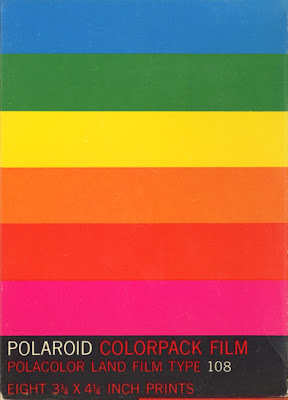
First up is my oldest, a box of Type 108, expired November 1976.

Now that is a pretty box. Bought as a collector's piece, but I tried to use the film, of course. I think someone once left a slightly negative comment around here about expired film and that it should be in a museum. I think it was disdain, but maybe I'm wrong. But, anyway, the thing about film is...it just goes bad. The older it gets, it just turns to plastic. So why not use it? I save everything else (wait until my exciting post about 120 paper backings!), but the film just turns to crap. And in the case of roll film, it actually can ruin the backing, bonding with it, making it that much more useless. Not much of a surprise, but film that doesn't work isn't worth much, no matter the pretty box around it. I think I paid maybe 8 bucks for this beauty. And the film? Completely useless. Dry as a bone. But the box has aesthetic value to me, and I collect stuff (unfortunately). And I was a child in the 70s, so flashbacks galore. Memories of sitting at Grandma's and reading Humpty Dumpty magazines with monster movies on channel 32, WFLD out of Chicago on Saturday afternoon.
Moving on...here's some stuff that was inside the box, including the instructions.




I've never used the cardboard backings. I'm not much into ruining my photos (no gluing family photos into an album like my grandmother did). But I have a bunch of them...maybe be of some use someday. For the dupes photos, they must have used a copier and took another shot and made a neg or something.
Next up is a pack of Type 88, expired September 1977, along with a dupe mailer.


I haven't used this film. I figure it can't be much better off than the 108. Maybe I'll rip into it some day, maybe I'll leave it alone. It lives in the fridge now.
We jump to a box of black and white Type 107, expired July 1983.

I have three boxes, sans film. I used the film. It actually worked quite well. Had to up the contrast a bit when scanning, but the results were lovely. I used the original goop stick. It was still goopy, but coverage was a bit off. That's okay...part of the fun.

And here are the instruction that came in the box:


This Type 668 I bought without a box, and probably spent too much for it. The date on the pack is 1984, so it expired sometime in the 80s, I assume.

It didn't really work. A little tiny bit, but mostly not at all.


At least I was entertained for a few minutes. And I discovered that you can take a pack out in daylight and only the top shot will be exposed. Not that you want to waste film, but when I first loaded this film, I was out in the desert, and after a couple shots decided I wanted film that worked, so I took it out and saved it.
Here is box of Type 88 that expired September 1996. Much newer, and much nicer results. You can see the transition from the rainbow to the blue, or 'blah' box.

And, for good measure, here is the current 'blah' box.

Though not for long, as evidenced by this nasty sticker:

Sad, sad days. I have a stash of Polaroid, but it's going to suck when I run out. Can't even find Type 80s anywhere. Still a fair amount of Type 100 (667, 669, etc.) and Fuji makes an instant film that fits 100 film backs...soon, though, it may all be gone.
Just for fun, a few scans from some old instruction booklets. First a quick guide to taking (or...MAKING) a Polaroid photo. When I bought my Square Shooter, I had to scratch my head a minute to figure out how to pull the film out. I had a Polaroid when I was a kid, but that was 25-30 years ago. Another more stupid than funny story, but the first pack I shot a couple years ago, all the photos came out black, UNLESS I was just aiming at the road...then they were boring but it worked. It took me two days to figure out: I KEPT AIMING DIRECTLY AT THE SUN. Dumbass. Screws up the meter.

A few groovy pictures here, teaching you some basic photography. Digging the shot of the guy just released from prison.

Last, we have a page of helpful tips, or what they snidely refer to as "trouble". Never had the white vertical bars on my photos. Gonna have to try that one out! More ways to abuse my film...

And only medium-fast...not slow-fast or fast-fast. Just...medium-fast. Words to live by. Peace.























